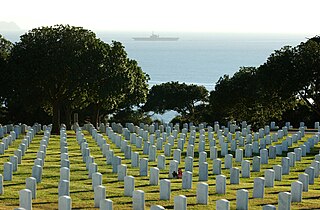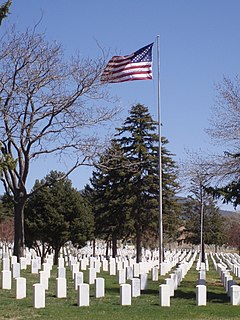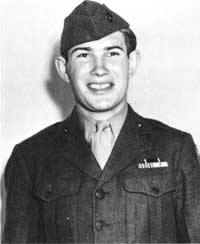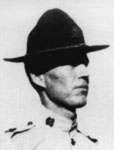
The Distinguished Service Cross (DSC) is the United States Army's second highest military decoration for soldiers who display extraordinary heroism in combat with an armed enemy force. Actions that merit the Distinguished Service Cross must be of such a high degree that they are above those required for all other U.S. combat decorations, but which do not meet the criteria for the Medal of Honor. The Army Distinguished Service Cross is equivalent to the Navy and Marine Corps' Navy Cross, the Air Force and Space Force's Air Force Cross, and the Coast Guard Cross. Prior to the creation of the Air Force Cross in 1960, airmen were awarded the Distinguished Service Cross.
The Haitian Campaign Medal was a United States Navy military award which was first established on June 22, 1917, and again on December 6, 1921.

Fort Rosecrans National Cemetery is a federal military cemetery in the city of San Diego, California. It is located on the grounds of the former Army coastal artillery station Fort Rosecrans and is administered by the United States Department of Veterans Affairs. The cemetery is located approximately 10 miles (16 km) west of Downtown San Diego, overlooking San Diego Bay and the city from one side, and the Pacific Ocean on the other. Fort Rosecrans is named after William Starke Rosecrans, a Union general in the American Civil War. The cemetery was registered as California Historical Landmark #55 on December 6, 1932. The cemetery is spread out over 77.5 acres (31.4 ha) located on both sides of Catalina Blvd.
The Military Order of the Loyal Legion of the United States (MOLLUS), or simply the Loyal Legion is a United States patriotic order, organized April 15, 1865, by three veteran officers of the Army. The original membership was composed of members of the Army, Navy, or Marine Corps of the United States, who had served during the American Civil War as commissioned officers in Federal service, or who had served and thereafter been commissioned, and who thereby "had aided in maintaining the honor, integrity, and supremacy of the national movement" during the Civil War.

William Jennings Bordelon Jr. was a United States Marine who served in combat during World War II. During the Battle of Tarawa, he was killed in action while he led the assault on the enemy and rescued fellow Marines. For his acts of gallantry, he was posthumously awarded the United States' highest military honor — the Medal of Honor. He was the first U.S. Marine from Texas to be awarded the Medal of Honor for action in World War II.

Riverside National Cemetery (RNC) is a cemetery located in Riverside, California, dedicated to the interment of United States military personnel. The cemetery covers 1,250 acres (510 ha), making it the largest cemetery managed by the National Cemetery Administration. It has been the most active cemetery in the system since 2000, based on the number of interments.

1st Battalion, 4th Marines (1/4) is an infantry battalion in the United States Marine Corps based out of Marine Corps Base Camp Pendleton, California consisting of approximately 800 Marines and sailors. They fall under the command of the 1st Marine Regiment and the 1st Marine Division.

Santa Fe National Cemetery is a United States National Cemetery in the city of Santa Fe, in Santa Fe County, New Mexico. It encompasses 84.3 acres (34.1 ha), and as of 2021, had 68,000 interments. Administered by the United States Department of Veterans Affairs, it is one of two national cemeteries in New Mexico. It was listed on the National Register of Historic Places in 2016.

Cypress Hills National Cemetery is a 18.2-acre (7.4 ha) cemetery located in the Cypress Hills neighborhood of Brooklyn, New York City. It is the only United States National Cemetery in New York City and has more than 21,100 interments of veterans and civilians.

Richard Keith Sorenson was a United States Marine who, as a private, received the Medal of Honor during World War II for his heroism during the Marine landing on Kwajalein Atoll on the night of February 1–2, 1944. He threw himself on an exploding Japanese grenade that was part of US munitions captured during the Battle of Bataan, to save the lives of five fellow Marines. Although fragments of the grenade ripped through his thighs, hips, right arm and right leg, he survived the action. Of the 27 Marines who similarly threw themselves on grenades to save the lives of their fellow Marines during World War II, Sorenson was one of only four who lived. Fellow Medal of Honor recipients Richard E. Bush, Jacklyn H. Lucas and Carlton R. Rouh were the other three survivors.

Captain John James McGinty III was a United States Marine Corps officer who received the United States militaries' highest decoration — the Medal of Honor — for heroism during July 1966 in the Vietnam War.

William Robert Button was a United States Marine Corps corporal who received the Medal of Honor for his actions in killing Haitian nationalist leader Charlemagne Peralte on October 31–November 1, 1919. Button rose to the rank of sergeant before dying at age 25 from malaria.

Puerto Ricans have served as members of the United States Armed Forces and have fought in every major conflict in which the United States has been involved from World War I onward. Many Puerto Ricans, including those of Puerto Rican descent, have distinguished themselves during combat as members of the five branches of the U.S. Military, the Army, Marines, Navy, Air Force and the Coast Guard.
Hispanics in the United States Marine Corps, such as Private France Silva who during the Boxer Rebellion became the first Marine of the thirteen Marines of Latin American descent to be awarded the Medal of Honor, and Private First Class Guy Gabaldon who is credited with capturing over 1,000 enemy soldiers and civilians during World War II, have distinguished themselves in combat. Hispanics have participated as members of the United States Marine Corps in the Boxer Rebellion, World War I, the American intervention in Latin America also known as the Banana Wars, World War II, the Korean War, the Vietnam War, the Gulf War and most recently in the military campaigns of Afghanistan and Iraq.











